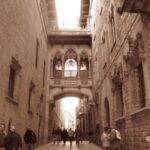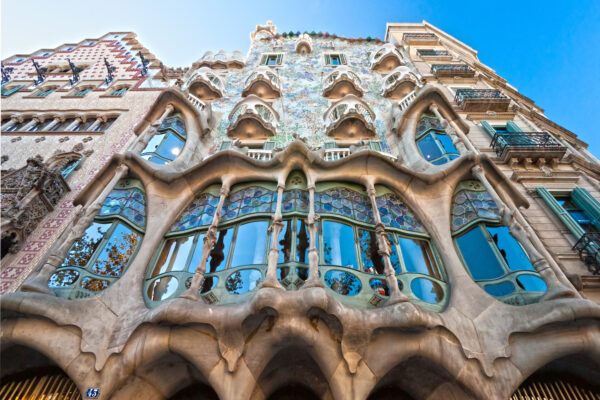
Antoni Gaudí, a visionary architect of the late 19th and early 20th centuries, transformed the skyline of Barcelona with his unique and imaginative designs. His works reflect a deep connection to nature, intricate craftsmanship, and a distinct style that defies conventional architectural norms.
Among his most celebrated contributions, **Gaudí's iconic modernist buildings in Barcelona** showcase a harmonious blend of colors, shapes, and symbolism. Each structure tells a story, inviting visitors to explore the whimsical yet profound essence of his architectural genius.
Exploring Gaudí's Masterpieces: A Guide to Barcelona's Modernist Architecture
Exploring the masterpieces of Antoni Gaudí offers more than just a visual feast; it is a journey into a world where architecture meets art. Visitors can immerse themselves in the unique **modernist architecture** that defines Barcelona, experiencing firsthand how Gaudí's designs celebrate the organic forms of nature. Each building is a testament to his innovative spirit and philosophical approach.
Among the standout features of Gaudí's work are the flowing lines and vibrant colors that characterize his designs. Key structures to explore include:
- La Sagrada Família - A monumental basilica that has become a symbol of Barcelona.
- Casa Batlló - Renowned for its skeletal structure and colorful façade, a true representation of Gaudí's creativity.
- Park Güell - An enchanting public park filled with whimsical mosaics and architectural marvels.
- Casa Milà (La Pedrera) - Famous for its undulating stone facade and rooftop chimneys that resemble warriors.
Each of these iconic buildings not only showcases Gaudí's distinctive style but also reflects his deep understanding of **environmental harmony**. His work serves as an inspiration for modern sustainable architecture, emphasizing the importance of integrating structures with their surroundings. A visit to these sites is essential for anyone wishing to grasp the essence of Barcelona's architectural landscape.
To truly appreciate Gaudí's genius, consider the following aspects during your exploration:
- Symbolism - Look for hidden meanings in the designs, often inspired by religion and nature.
- Craftsmanship - Notice the meticulous attention to detail in the materials and techniques used.
- Innovation - Observe how Gaudí challenged traditional architectural norms to create something entirely new.
The Unique Architectural Style of Gaudí: Characteristics and Influences
Antoni Gaudí's architectural style is characterized by its **organic forms**, vibrant colors, and intricate details, which draw heavily from nature. His designs are often marked by **curvilinear shapes**, reminiscent of the natural landscape, and an absence of straight lines. This approach creates a sense of fluidity and movement, making his buildings feel alive and integrated into their surroundings.
Another significant aspect of Gaudí's work is his innovative use of materials. He combined traditional materials like stone and brick with modern techniques, including **trencadís**, a type of mosaic made from broken tiles. This method not only added a unique texture to his buildings but also allowed him to play with color and light in unexpected ways. The result is an architectural style that is both **timeless** and profoundly imaginative.
Gaudí was also influenced by various cultural and artistic movements, such as **Art Nouveau** and Gothic architecture, which he blended into his unique vision. His works often reflect a strong **spirituality**, with many designs inspired by religious themes and natural symbolism. This fusion of styles elevates his buildings beyond mere structures, turning them into spiritual experiences that resonate with visitors.
To summarize, the key characteristics of Gaudí's architectural style include:
- Organic integration - Buildings that harmonize with nature.
- Innovative materials - Use of trencadís and other non-traditional techniques.
- Spiritual symbolism - Designs that convey deeper meanings and narratives.
- Fluid forms - Aesthetic that emphasizes curves rather than straight lines.
A Closer Look at Casa Batlló: Features and Significance in Modernism
Casa Batlló, one of Gaudí's most iconic modernist buildings, exemplifies the architect's innovative approach to design. Completed in 1906, this masterpiece stands out for its organic forms, vibrant colors, and intricate details. The structure's façade, reminiscent of a dragon's skin, features a blend of iridescent mosaics and flowing lines that convey a sense of movement and life, making it a quintessential representation of modernism.
The architectural features of Casa Batlló highlight Gaudí's unique vision and his ability to integrate elements of nature into urban living spaces. Key characteristics include:
- Skeletal structure - The building's support system is seamlessly hidden within the flowing forms.
- Colorful mosaics - The trencadís technique, made from broken tiles, enhances the building's vibrant appearance.
- Organic motifs - Curved windows and balconies designed to mimic natural shapes, inspired by marine life.
In addition to its aesthetic appeal, Casa Batlló serves as a significant cultural artifact within the context of modernism. It reflects the early 20th-century shift towards a more expressive and imaginative architectural style, showcasing Gaudí's pioneering spirit. The building's design represents a break from traditional architectural conventions, emphasizing creativity and individualism.
Visitors to Casa Batlló are often captivated by the building's enchanting atmosphere and the attention to detail evident throughout. Key points to appreciate during a visit include:
- Lighting design - Natural light floods the interior, enhancing the vibrant colors and textures.
- Symbolic elements - Look for references to legends and natural phenomena woven into the architecture.
- Environmental integration - The layout promotes harmony with its surroundings, embodying Gaudí's vision of sustainable design.
La Sagrada Familia: Gaudí's Unfinished Symphony of Art and Faith
La Sagrada Familia, Gaudí's magnum opus, is often described as a cathedral that tells a story of spirituality and artistry intertwined. This monumental basilica, still under construction since its inception in 1882, represents a unique blend of Gothic and Art Nouveau styles. Gaudí's vision was not merely to create a place of worship but rather to craft a sacred space that embodies the essence of Christianity through architectural expression.
The basilica's intricate facades, each with its own narrative, are adorned with symbols and figures that invite contemplation. The Nativity Façade celebrates the birth of Christ, while the Passion Façade reflects the suffering and sacrifice of Jesus. These designs are not just decorative; they serve as visual sermons that engage visitors on a spiritual level. Key elements of La Sagrada Familia include:
- Verticality - Towering spires reaching towards the heavens symbolize aspiration and divinity.
- Naturalistic forms - Organic shapes that mimic nature, reflecting Gaudí's belief in the divine presence within the natural world.
- Innovative use of light - Stained glass windows that filter sunlight, creating a kaleidoscope of colors inside the basilica.
Despite its ongoing construction, La Sagrada Familia has already achieved iconic status, drawing millions of visitors each year. Gaudí's dedication to craftsmanship and his intricate designs inspire not only awe but also a deeper understanding of the connection between art and faith. The basilica is a testament to the architect's belief that every detail contributes to the greater whole, echoing the idea that faith itself is a complex tapestry of human experience.
As visitors walk through La Sagrada Familia, they are not merely observing an architectural marvel; they are experiencing a symphony of art and faith. Each corner of this magnificent structure resonates with Gaudí's spiritual vision, making it a must-see for anyone interested in modernist architecture and the profound impact of artistry in the realm of spirituality.
Park Güell: A Colorful Expression of Gaudí's Vision in Urban Design
Park Güell is a vibrant testament to Antoni Gaudí's artistic vision, merging architecture with nature in a public space that captivates visitors. Originally conceived as a residential project, it evolved into a magical park filled with whimsical structures and colorful mosaics. The use of organic forms and bright colors exemplifies Gaudí's intent to create an environment that feels alive, inviting exploration and interaction with the landscape.
The park features several iconic elements that reflect Gaudí's innovative approach to urban design. Notable highlights include:
- The Serpentine Bench - A winding seat adorned with trencadís mosaics that invites communal gathering and relaxation.
- El Drac (The Dragon) - A striking mosaic-covered salamander, symbolizing the fusion of fantasy and nature.
- The Hypostyle Room - Supported by 86 columns, this area showcases Gaudí's ability to create spaces that harmonize with their surroundings.
Park Güell’s design encourages visitors to appreciate the beauty of the natural world, aligning with Gaudí's belief that architecture should exist in harmony with its environment. The park's layout integrates the surrounding landscape, using terraces and pathways to guide visitors through a colorful journey. This seamless blend of art and nature exemplifies Gaudí's unique vision of urban design, making Park Güell a quintessential example of his modernist philosophy.
In addition to its aesthetic appeal, Park Güell serves as a cultural landmark, inspiring future generations of architects and artists. The park's vibrant mosaics and organic shapes not only reflect the playful spirit of Gaudí's work but also invite contemplation of the relationship between humans and nature. As a result, Park Güell stands as a colorful expression of Gaudí's vision, emphasizing the importance of creativity in urban spaces.
The Legacy of Antoni Gaudí: How His Work Shaped Barcelona's Identity
The legacy of Antoni Gaudí is intricately woven into the identity of Barcelona, shaping its architectural landscape and cultural ethos. His innovative approach to design inspired a movement that transcended traditional boundaries, establishing a unique style that is instantly recognizable. Gaudí's mastery in blending functionality with artistic expression not only defined an era but also laid the groundwork for future architects who sought to challenge conventional norms.
Central to Gaudí's influence is his ability to connect architecture with nature, creating structures that seem to grow organically from the environment. His commitment to environmental harmony is evident in various projects, where he integrated natural elements and local materials to create a symbiotic relationship between the built and natural worlds. Key aspects of his legacy include:
- Integration of nature - Buildings that reflect their surroundings and enhance the landscape.
- Innovative materials - Use of traditional and modern techniques that pushed the boundaries of architectural design.
- Cultural symbolism - Architecture that tells stories and represents the cultural heritage of Barcelona.
Gaudí's work has also become a powerful symbol of Barcelona's identity, attracting millions of visitors from around the globe. His masterpieces, such as La Sagrada Família and Park Güell, are not merely tourist attractions; they embody the spirit of a city that values creativity and innovation. This cultural significance reinforces Barcelona’s status as a hub of modernist architecture and an inspiration for cities worldwide.
As Gaudí's buildings continue to inspire awe and admiration, their lasting impact is a testament to his visionary genius. His work has ignited a passion for architectural excellence that resonates with contemporary designers, who strive to capture the unique essence of place while respecting the environment. Ultimately, Gaudí’s legacy is a celebration of the potential for architecture to transform not only skylines but also the very identity of a city.
 Explore the Gothic Quarter on a Guided Tour
Explore the Gothic Quarter on a Guided Tour Barcelona Airport to Sagrada Familia: Ways to Get There
Barcelona Airport to Sagrada Familia: Ways to Get There Central Grand Hotel - Exquisite Accommodations
Central Grand Hotel - Exquisite AccommodationsIf you want to know other articles similar to Gaudí's iconic modernist buildings in Barcelona you can visit the category WHERE YOU CAN GO.
Leave a Reply










Read more!